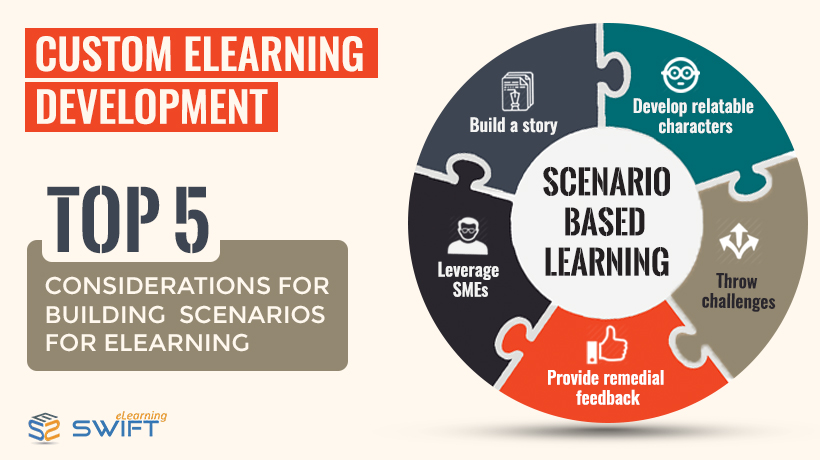Custom Elearning Development: Top 5 Considerations for Building Interactive Scenarios for ELearning
Custom eLearning if designed correctly, tailored to organizational needs, can create immersive and engaging learning experiences. Incorporating the contextual scenarios (scenario-based training) woven with story-telling approach can take your custom eLearning courses to the next level. We, at Swift, provide cost-effective custom eLearning solutions that not only enhances your corporate training but brings improved performance on the job.
As an e-learning designers our job is to create engaging eLearning experiences that help the learners to improve their job performances. To design such impactful experiences, scenario-based learning approach as part of custom eLearning is one of the proven instructional design strategies. Scenario is a form of storytelling where the learners are put in a context or situation and allowed to make decisions and learn through the consequences of the choices they make.
In the scenario-based environment, the learner gets engrossed as the scenario unfolds. Sounds pretty easy, but building apt scenarios is not an easy task and involves significant time and skill. At times, instructional designers feel overwhelmed and struggle to come up with the right scenario for the specific learner groups.
In such situations, we just need to stick to basics and keep the scenario relevant and straightforward. To get the learners involved in the scenario, we need a perfect context, engaging storyline/plot, realistic characters, a bit of suspense, intuitive decision points and remedial feedback.
This blog post will help you build the scenario-based eLearning that really speak to your learners and make your eLearning count. Check out the branching scenario sample on “How to Deal with Workplace Bullying” which has been created using Adobe Captivate at the end of this blog.
Here are the five considerations for building engaging and effective scenario-based eLearning as part of custom eLearning content development.
1. Leverage your Subject Matter Experts (SMEs): SMEs are valuable resources with extensive knowledge on the subject. Since SMEs understand the performance problems, discussions with them will help contextualize the scenario and build a great narrative. To get the most out of SME:
- Start posing questions about the employee performance problems and solutions to rectify them
- Understand the context and make sure to bring it into the scenarios
- Recognize the consequences of wrong decisions and make it as learning points
2. Build a story: Scenarios are all about the contextual stories, which mirror the real world events. Stories that are relevant can connect well with the learners. The story will be a success only when the learners get involved. Relevancy adds value to the stories and help you set the workplace context. SMEs are the best resources to help you identify the context relevant to the learners. Once you identify the context, build the story that showcases the situations to meet the performance goals. Make sure to provide a background of the story.
3. Develop relatable characters: It is a fact that we are all influenced by our emotions and moods. In order to make the scenario interesting, develop the characters that are real so that the learners can relate with them. You can use speech bubbles to display conversational dialogues between the characters. Knowing your learners and their background will be very helpful while crafting these characters. After all, you cannot create the characters of a doctors and nurses while the course is about the mutual funds.
4. Throw the real world challenges: As the scenario unfolds, present the learners with a set of challenges or problems as decision points and compel them to think and respond to the given situations. Add suspense to make it more interesting. Do not spoon feed the learners and provide any hints. Let them think and discover through their own mistakes.
5. Provide customized remedial feedback: Once the learners make decision or choose the response, demonstrate the consequences of their decisions. Provide the customized feedback with logic for each response. In this way, the learners can learn from their mistakes.
Summary:
To wrap up what we’ve discussed, creating scenario-based eLearning involves the right blend of contextual stories, understanding the performance problems, developing relatable characters, compelling learners to respond to job-relevant situations and providing the right feedback based on their decisions.
If you are opting for custom eLearning or looking to convert your classroom-based training, then we can help you achieve your requirement. Our expert instructional designers and visual designers are highly capable of bringing your existing training content to life with creative interactivities, animations, challenging activities, branching scenarios and video content.
Our Services: Convert PowerPoint to eLearning, eLearning Translation Services, eLearning Vendor




Leave a Reply
Want to join the discussion?Feel free to contribute!